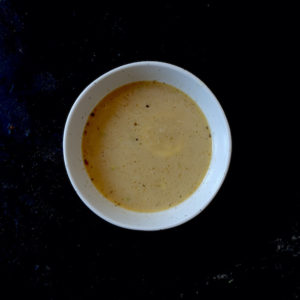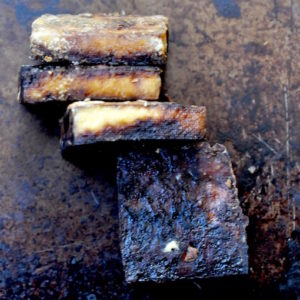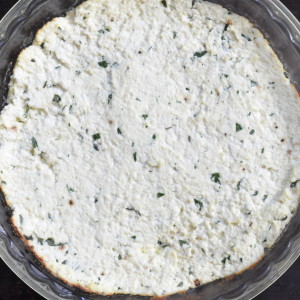Asian Style Noodle Soup with Greens
The inspiration for Asian Style Noodle Soup with Greens comes from Mollie Katzen’s Vegetable Heaven. While today’s recipe is quite different from Katzen’s, but I believe in credit where it’s due.
If you are unfamiliar with Katzen’s books, I encourage you to seek them out. A friend lent me The Enchanted Broccoli Forest in the mid 1990’s, before both the internet and the foodie revolution. Ingredients like lemongrass, tamari sauce, and tofu were unfamiliar to many of us. So was the idea that vegetarian food could be interesting, approachable, and delicious. Katzen’s books went a long way toward changing those perceptions.

—
Into the kitchen.
This is a rare instance where I recommend using either chicken or vegetable stock to make Asian Style Noodle Soup with Greens. This stock may be homemade, from a jar, or be an artisanal bone broth prepared in reclaimed copper stills. Whatever the case, avoid water, which may result in a bland soup.

Not broth. I had no broth picture. So this is a mini-harvest festival. Like I ever get near a farm.
Western soups have their soffrittos and mirepoix. Chinese dishes often begin with stir-frying minced garlic, ginger, and scallion. All three went into to the soup pot, along with star anise.

Dried mushrooms are another excellent way of adding flavor. Decant dried mushrooms into glass preserving jars, if possible. They’ll keep indefinitely in a cool, dry place. A few go far.

Fresh shittake mushrooms proved less fresh than promised. I was able to use a few. The rest went into the compost. None were especially photogenic.

More harvest festivity.
The world’s grittiest bok choy. So gritty you can see it in the picture.

Like many Americans, I have been the tiniest bit distracted lately. I mean, whole, bone-in, skin-on chicken thighs for soup? Um, more flavorful, sure, but boneless would be just fine here.

The chicken wasn’t very pretty.
After 45 minutes, I removed the chicken from the soup, let it cool, then meat from the bones. I cut it into small pieces and returned it to the pot. You can avoid this kefluffle: buy boneless.

Also not chicken.
The Seasoning….
As mentioned above, Asian Style Noodle Soup with Greens needs careful seasoning or you’ve got a pot of blandness.
This isn’t a cue to empty the spice cabinet into the soup. Instead, use a measuring spoon for liquid seasonings, ensuring your carefully assembled soup doesn’t get ruined by spilled vinegar or the error known as “the soy sauce lake mistake.”

Never heard of the soy sauce lake mistake? I just made it up. The term, that is. I would venture you’re familiar with the mistake.
The noodles should be added to the soup just before serving time. Dried or fresh noodles are fine. A wider noodle is preferable, but use whatever is available.

A final note:
The first time I served Asian Style Noodle Soup with Greens, we thought it nice enough but lacking.
The next day, I ladled out a half-cup of soup and tried to figure out what was missing. More brown rice vinegar made the soup more acidic.

Tomato paste didn’t hurt, but it didn’t help. Fresh lime juice made the soup unpleasantly acidic.

Sugar was the winner. Just a small sprinkling made a remarkable difference, smoothing the soup’s rough edges and rounding out the flavors. In almost thirty years of cooking, this is the first time I’ve added sugar to soup. Live and learn.

—
Asian Style Soup with Greens is endlessly mutable–there is nothing in the recipe that cannot be altered, making this an incredibly useful soup as we enter the cooler months.

Asian Style Noodle Soup with Greens may be served as is, or with a scatter of cilantro, as pictured above. Bottles of soy sauce, various chili pastes, sesame oil, and vinegar may also be served at the table so diners can customize their soups.
Asian Style Noodle Soup with Greens
Prep: the vegetables need to be washed and trimmed. If you are using chicken, it needs cutting. Soup takes about 70 minutes to cook. It may be left on the stove over very low heat up to three hours.
Yield: approximately 6-8 cups soup
Please read the notes, below, before starting to cook.
4 dried Chinese mushrooms
1 star anise
1 slice fresh ginger
2-3 garlic cloves
4-6 scallions, trimmed and thinly sliced
2 ounces/1/4 cup/60 grams fresh shittake mushrooms (or more, if wished)
1-1.5 pounds/454-680 grams Bok Choy, Baby Bok Choy, Chinese Broccoli, Gai Lan, or other greens
peanut or other mild oil, for the soup pot
6 cups chicken or vegetable broth, homemade or low salt commercial broth
2 tablespoons soy sauce (not “lite”)
2 tablespoons Shaoxing rice wine
2 tablespoons Chinkiang or Brown Rice Wine Vinegar (not Mirin!)
2 teaspoons sugar; taste: you may need to add more
a tiny smatter of hot red pepper flakes
Generous drizzle sesame oil
salt and pepper to taste
approximately 1 pound/454 grams boneless, skinless chicken thighs
2-4 ounces/60-80 grams dried or fresh noodles per diner
Fresh cilantro
To serve at table:
soy sauce
chili paste or hot pepper oil
Chinkiang or brown rice vinegar
Heat just under 1/2 cup water in a microwave safe bowl. Carefully add dried mushrooms. I poke them down with a spoon. Leave to soak for at least 20 minutes. They can sit up to four hours.
Slice ginger thinly–no need to peel. Set aside.
Crush and peel garlic. Mince and place with ginger.
Trim scallions and slice thinly. Put with ginger and garlic.
Wipe Shittake mushroom caps. Trim stems. Slice mushrooms thinly. Set aside.
Wash greens thoroughly, ensuring no grit lingers in leaves or stems. Dry just enough to prevent water splattering all over your cutting board. Chop greens into pieces, remembering they will be eaten with a spoon.
Place your largest soup pot on the stove. Pour about two tablespoons peanut oil into the pot and heat to medium low. There should be enough oil to cover entire bottom of pot. Add more if necessary.
Add garlic, ginger, scallions, and star anise to pot. Cook at gentle simmer, stirring often, for about 8 minutes. Do not allow ingredients to brown.
Add shittake mushrooms and greens to pot.
Check on dried mushrooms: they should be soft now. Squeeze them dry and slice thinly, discarding hard stem. Soaking water may be poured through a coffee filter or fine strainer and added to soup pot.
Add broth to pot. There should be enough to cover ingredients by 2-3 inches/4-7 cm. Bring soup to simmer.
Season soup with soy sauce, rice wine, vinegar, sugar, hot pepper flakes, sesame oil, salt, and pepper.
Allow soup to simmer gently for just over an hour, stirring occasionally.
Taste for salt, sugar, and pepper. If you think soup needs more soy, rice wine, or vinegar, add it in 1/2 teaspoon amounts. You can always add more.
45 minutes before serving time, slice chicken into spoon-sized pieces. Add to broth. Do not taste broth until chicken has cooked through; this takes about 30 minutes.
I used dried noodles that take minutes to cook, so prepare them just before serving the soup. Prepare your noodles accordingly. Fresh noodles take only 2-3 minutes.
Serve soup either in a large tureen or individual bowls.
Top each serving with a scattering of fresh cilantro leaves. (Unless you have cilantro haters at the table!)
Asian Style Noodle Soup with Greens keeps, refrigerated, up to three days; to keep refrigerated longer, reheat thoroughly.
Freeze soup up the three months.
Notes:
As mentioned in the post, Asian Style Noodle Soup with Greens is infinitely flexible. Pretty much every ingredient in the recipe may be replaced: use chard instead of Bok Choy, firm tofu instead of chicken, vegetable broth instead of chicken, and so on.
Use one green or a mixture: I used bok choy and spinach.
Replace noodles with rice: either cook in the soup or prepare separately. Preparing the rice separately allows you to serve it separately. Rice cooked in the soup with soften, swell, and expand.
A wide variety of Asian noodles are available at Asian markets and better supermarkets. This is a question of personal preference. If you cannot find Asian noodles, dried or fresh Italian noodles are fine. Use your favorite, or seek out wide, flat noodles.
Like rice, noodles swell when left in the soup pot. To avoid this, prepare and serve noodles separately. This is wise if you want to freeze any leftover soup, as frozen cooked noodles become mushy.




